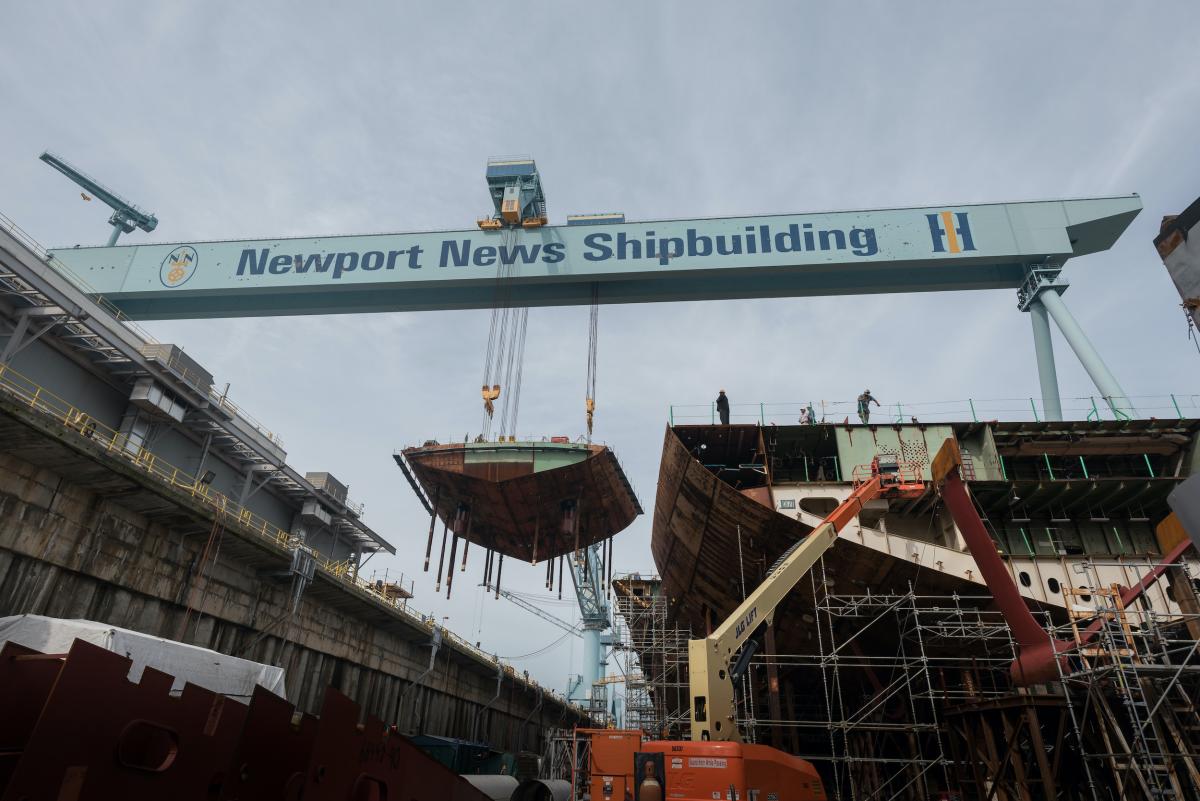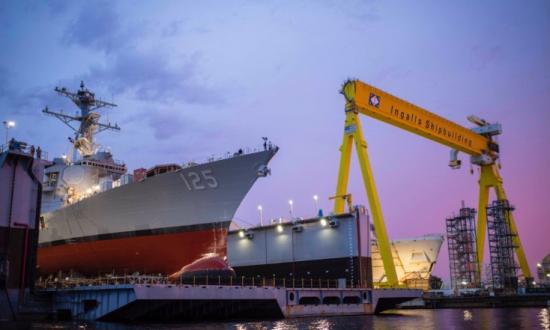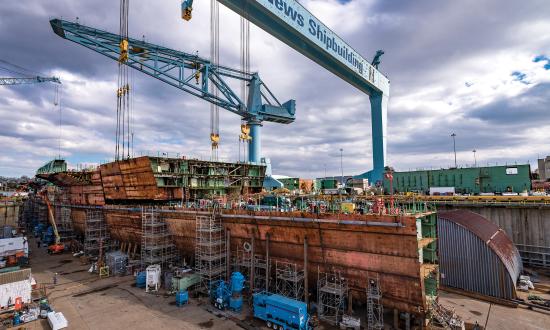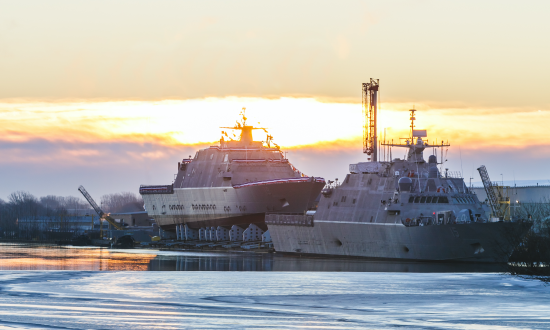As pressures on the global supply chain continue disrupting the U.S. economy, there is a great deal of conversation about the causes, impacts, and solutions. But only focusing on the current global supply chain disruption will not solve the short- and long-term challenges facing the national-security supply chain.
The hard reality is supply chain challenges run deep. However, the good news is there are several actions that Congress, the Administration, and the Navy can take now that will chart a path forward to ensure a strong and capable national-security industrial base.
More than 2,000 supply chain companies stretching across the nation deliver products and services to build and maintain the U.S. Navy aircraft carrier fleet. These companies comprise more than 92,000 essential workers who design, weld, build, and maintain the components that go on nuclear-powered aircraft carriers. These companies not only supply public-sector programs, but most of the businesses count on commercial contracts too.
The companies are privileged to be part of the national security industrial base. Some of the parts from factory floors spend 50 years sailing with America’s bravest men and women. With this mission-driven focus, supply-chain companies strive to meet orders on time, every time—for the taxpayer and warfighter—even in the face of headwinds.
Long-Term Threats to the Supply Chain Go Beyond Current Disruptions
Last October, when talking about the global supply-chain disruptions, Vice Admiral William Galinis, Commander, Naval Sea Systems Command, told an audience at the American Society of Naval Engineers’ Fleet Maintenance and Modernization Symposium, “We’re starting to see additional longer lead time for material, for parts, and for raw stock and everything like that. I think that’s something we’re going to have to continue to work our way through.”
Over the past two years, this industrial base has faced a global pandemic, economic downturns, the government operating under a continuing resolution, and now a global supply-chain crisis. This has the attention of the nation and its leaders—as it should––while the industrial base is working with customers to mitigate the impact and delays.
But for the national-security industrial base, the headwinds facing the supply-chain run deeper and are mostly confined within the domestic supply chain. If Washington wants to strengthen and stabilize the supply chain, it is critical that Congress and the Administration take action to ensure the long-term health and strength of the industrial base. Current supply-chain disruptions are having an impact, but there are greater long-term issues that are more of a threat.
The Aircraft Carrier Program Relies on Certainty and Stability
For a shipbuilding program like nuclear-powered aircraft carriers, maintaining a healthy, capable supply chain starts with a predictable demand signal for orders and work, which means annual funding for building and maintaining a fleet of at least 11 carriers.
Government leaders have recognized the benefit of multi-ship buys to enable the supply chain to invest in new equipment, technology, and a workforce positioned to design and build ships that evolve with a national security strategy. To this end, the Navy signed a two-ship buy of two Ford-class carriers in January 2019, the Enterprise (CVN-80) and Doris Miller (CVN-81).
This two-ship aircraft carrier buy saved taxpayers $4 billion and injected stability and local investment into the aircraft carrier supply chain. The industrial base could not imagine having to survive the last two years without the two-ship buy.
In the summer of 2020, the Aircraft Carrier Industrial Base Coalition (ACIBC) surveyed its members, and six out of ten companies said the Navy contracts helped save jobs, while nine out of ten suppliers said the multi-year contracts are important to the future health and future of their companies.
The Navy Has Given the Industrial Base a Clear Demand Signal for the Future
The aircraft carrier demand signal from the Navy seems clear with the release of its Navy Aviation Vision 2030-2035: “Large-deck CVNs remain effective, relevant, and potent year after year, and decade after decade, because they are adaptable platforms in which evolving air wings deploy. To that end, the FORD Class CVN represents a revolutionary jump in carrier aviation and the future of large deck, nuclear-powered aircraft carriers designed to fight and win over near-peer adversaries in GPC.”
To meet the Navy’s vision, Congress and the Administration must continue to pursue long-term procurement strategies that deliver savings for the taxpayers, stabilize the industrial base, and equip the warfighter with an advantage against all adversaries.
A clear long-term demand signal is part of the supply and demand equation. The other part is the supply, which with 2,000 domestic suppliers comes with challenges and opportunities.
An Essential, Skilled Workforce Is an Emerging Challenge
To start with the challenges, our skilled and essential workforce never stopped delivering orders during the pandemic. It never closed. It fought through. But as the industrial base looks to the future, it is confronted with workforce shortages and regulation challenges.
The worker shortage in manufacturing has been exacerbated by the COVID-19 pandemic, in which 1.4 million manufacturing jobs were erased, according to a Deloitte and The Manufacturing Institute report. While 820,000 jobs were added back by the end of 2020, a half-million positions have not been hired back, despite nearly that many job openings.
Overcoming these workforce challenges begins with a strong pipeline of skilled workers. Efforts are underway through public-private partnerships in certain U.S. regions. Workforce pipeline projects are enabling employers to recapitalize their workforce through recruiting, hiring, training, and retaining skilled workforce members with critical trade skills. For example, the Pennsylvania Pipeline Program is identifying employers with a hiring demand and training, coaching, and supporting them to establish a pipeline program to create a reliable talent acquisition and retention system. These efforts will help rehabilitate the industrial base back to strength.
As suppliers to the U.S. military, ACIBC companies know how to take and deliver on orders. But against these collective headwinds the supply chain is navigating uncharted courses.
To help traverse this course, ACIBC asks government leaders to:
- Continue strong investments by Congress and stable and predictable shipbuilding targets from the Department of Defense, allowing for growth in the capability and the capacity of the shipbuilding enterprise.
- Continue to make procurement decisions that deliver the highest quality product for the warfighter, at the best value for the government, and at the best price for the taxpayer. This means employing a multi-ship procurement strategy for future Ford-class procurements in FY 2028 (CVNs 82 and 83).
- Continue to invest in manufacturing workforce programs building the future generation of shipbuilding through advanced procurement funding to support supply base development and stability ahead of the potential Fiscal Year 2028 two-ship award.
This past November we celebrated National U.S. Navy Aircraft Carrier Month, and later this year marks the 100th anniversary of the first U.S. aircraft carrier commissioning, the USS Langley (CV-1). Surrounding both occasions there is optimism and excitement about the future of the aircraft carrier industrial base. The right decisions and policies today will put us on a path for another 100 years of greatness.






